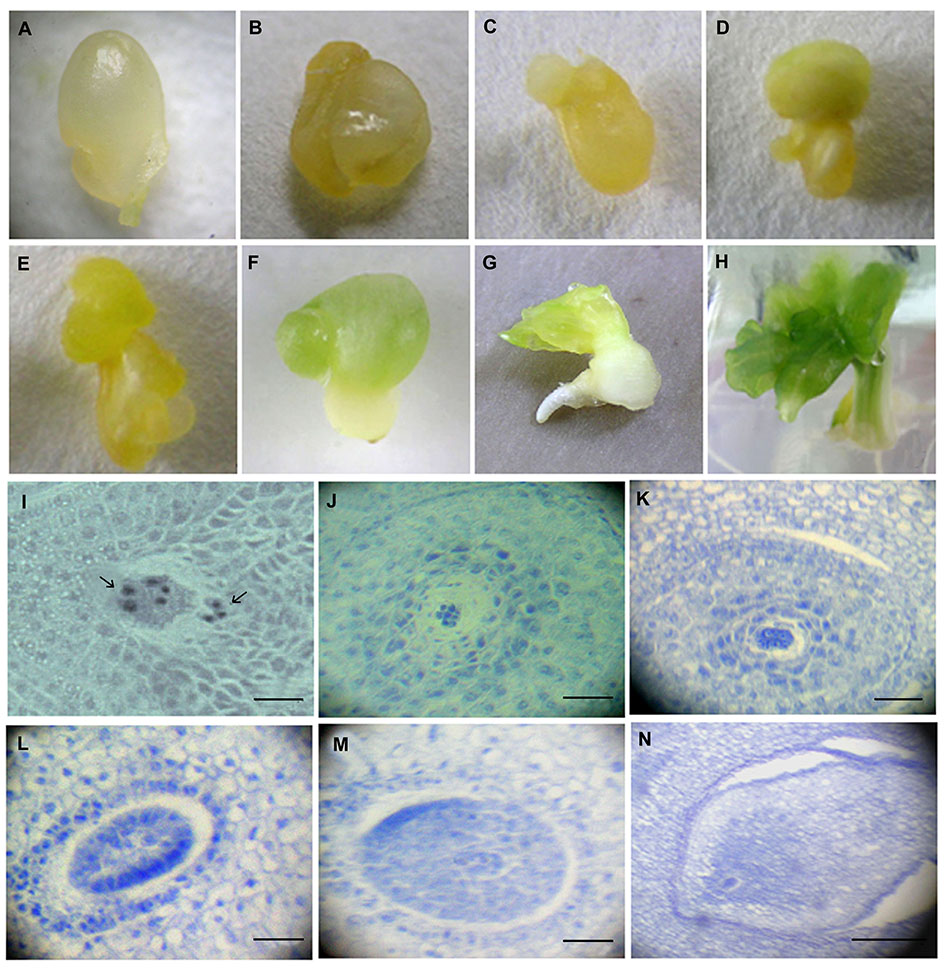以南瓜(Cucurbita moschata)品种试验1号为材料, 以未受精胚珠为外植体, 研究了激素种类、外植体发育时期、高温预处理时间和AgNO3浓度对胚状体诱导的影响。结果表明, 2,4-D、NAA和6-BA组合有利于胚状体的形成, 出胚效果最好的培养基为MS+1.0 mg·L–12,4-D+0.25 mg·L–1NAA+0.5 mg·L–16-BA, 出胚率达31.1%; 雌花开放当天的胚珠出胚率最高(26.7%), 且愈伤组织形成频率低(<5%); 外植体在黑暗、高温(35°C)条件下处理5天有利于胚状体的形成, 出胚率为32.2%。培养基中添加AgNO3对胚状体形成的抑制作用明显。胚状体转移至成苗培养基后可形成正常小苗, 出苗率最高可达64.3%, 植株再生过程经历了典型的胚胎发育途径。细胞学观察结果表明, 胚状体极有可能起源于胚囊珠孔端的细胞, 即卵细胞或助细胞。
We used unfertilized ovules of the pumpkin cultivar ‘Experiment 1’ as explants to examine the effect of combinations and concentrations of growth regulators, different developmental periods, high-temperature pretreatment, and AgNO3 concentrations on embryoid induction. The combination of 2,4-D, NAA, and 6-BA favoured embryoid induction; the medium with the best effect was Murishige and Skoog (MS)+1.0 mg·L–12,4-D+0.25 mg·L–1NAA+0.5 mg·L–1 6-BA, for 31.1% embryoid induction. The flowering ovules for the day showed the highest frequency of embryoid induction (26.7%) and the lowest frequency of callus formation (<5%). The explants treated with darkness and high temperature (35°C) for 5 days showed the best embryoid induction, 32.2%. However, the addition of AgNO3 remarkably inhibited embryoid induction. Transfer of embryoids to plant-regeneration medium led to the highest regeneration frequency, 64.3%. Plant regeneration expressed a typical pathway as for embryogenesis. Cytologic observations revealed that embryoids probably derived from cells close to the micropyle (i.e., ovums or synergids).

[1]Basu SK, Datta M, Sharma M, Kumar A.Haploid production technology in wheat and some selected higher plants[J].Aust J Crop Sci,2011,5:1087-1093
[2]Chen JF, Cui L, Malik AA, Mbira KG.In vitro haploid and dihaploid production via unfertilized ovule culture[J].Plant Cell Tiss Org Cult,2011,104:311-319
[3]Fei S, Read PE, Riordan TP.Improvement of embryogenic callus induction and shoot regeneration of buffalograss by silver nitrate[J].Plant Cell Tiss Org Cult,2000,60:197-203
[4]Gémes-Juhúsz A, Balogh P, Ferenczy A, Kristof Z.Effect of optimal stage of female gametophyte and heat treatment on in vitro gynogenesis induction in cucumber (Cucumis sativus L[J].). Plant Cell Rep,2002,21:105-111
[5]Lotfi M, Alan AR, Henning MJ, Jahn MM, Earle ED.Production of haploid and doubled haploid plants of melon (Cucumis melo L.) for use in breeding for multiple virus resistance. [J].Plant Cell Rep,2003,21:1121-1128
[6]陈学军, 刑国民, 陈竹君.西葫芦未授粉胚珠离体培养和植株再生[J].浙江农业学报,2000,12:165-167
[7]刁卫平, 陈劲枫, 雷春, 宋慧, 张晓青 .影响黄瓜未授粉子房培养胚发生因素的研究. [J].南京农业大学学报,2008,31(1):137-140
[8]冯大领, 孟祥书, 王艳辉, 刘霞, 李明, 赵锦, 白志英.植物生长调节剂在植物体细胞胚发生中的应用[J].核农学报2,2007,(3):256-260
[9]韩丽华, 王建, 陈贵林. AgNO3对甜瓜离体胚囊发育的影响. [J].河北农业大学学报,2005,28(2):48-50
[10]雷春, 陈劲枫.葫芦科蔬菜作物单倍体材料创制的研究进展[J].中国蔬菜,2006,(1):33-36
[11]潘莉, 杨铁钊.烟草未授粉子房胚状体诱导的研究[J].西北植物学报,2000,20(1):59-63
[12]孙守如, 翟庆慧, 胡建斌, 陈解放, 章鹏.几种生理因素对子房未授粉南瓜胚形成的影响[J].植物生理学通讯,2009,45(10):977-980
[13]王文和, 吴禄平, 赵玉萍 . 草莓未受精子房的离体培养. [J].中国农学通报,2011,27(13):177-182
[14]王文和, 吴禄平, 赵玉萍, 王超.草莓未受精子房离体雌核发育的研究[J].园艺学报,2011,38(8):1455-1461
[15]伍成厚, 潘一山, 罗开梅, 叶秀粦, 梁承邺.蝴蝶兰未受精胚珠离体培养的研究[J].园艺学报,2006,33(4):891-894
[16]谢冰, 王秀峰, 樊治成. 西葫芦未受精胚珠离体培养条件的优化及胚囊植株的产生. [J].中国农业科学,2006,39(1):132-138
[17]徐静.西葫芦雌核离体高效培养体系的建立.[J].博士论文. 乌鲁木齐: 新疆农业大学.,2007,:23-42
[18]阎华, 周嫦, 杨弘远.向日葵未受精胚珠培养中各种影响因素的实验研究[J].武汉植物学研究,1988,6(4):319-327
[19]杨江义, 李旭锋.植物雌性单倍体的离体诱导[J].植物学通报,2002,19(5):552-559
[20]张伶俐, 崔崇士, 屈淑平.植物离体雌核发育的研究进展[J].东北农业大学学报,2009,40(11):133-136



